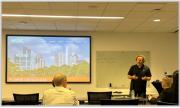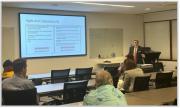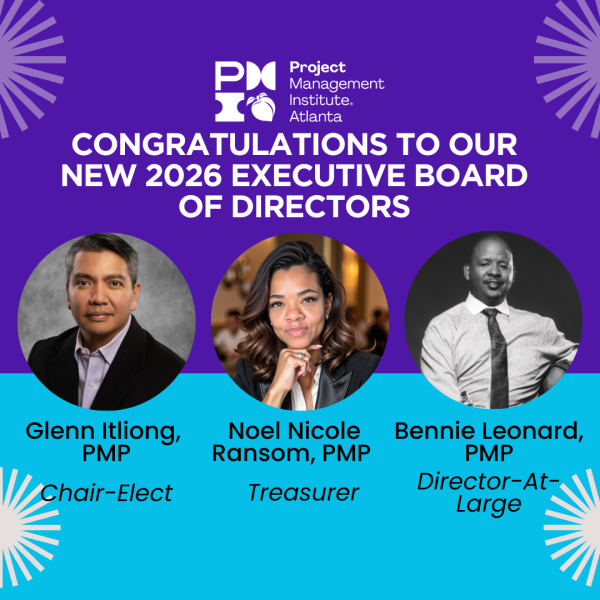The PMI Atlanta Chapter Nominations Committee is proud to present the following candidates to the membership. Each PMI Atlanta Chapter member will receive an email with a unique link to cast your vote.
Voting in the Chapter Elections will commence on Monday, September 25, 2025.
Meet the Candidates



Chair-Elect Candidates
 Glenn Itliong, PMP
Glenn Itliong, PMP
Born in the Philippines and raised between Manila and Lusaka, Zambia, I bring a multicultural perspective shaped by a globally diverse upbringing. I attended an English boarding school for high school, where I was introduced to a rigorous academic environment and a rich mix of cultures. I went on to earn a B.A. in International Relations and Philosophy from Saint Joseph’s University in Philadelphia, where I was honored with the President’s Award for Community Service for my volunteer work with Habitat for Humanity. To deepen my leadership and business expertise, I later completed an Executive MBA at Saint Mary’s College in Moraga, California. Professionally, I serve as a Senior Project Manager specializing in SaaS and IT implementations across global markets. I have successfully led complex implementations in the United Kingdom, India, Poland, Canada, and the United States, helping organizations streamline operations, adopt new technologies, and drive digital transformation. My work combines a strategic mindset with cultural fluency, enabling me to lead cross functional teams and deliver results in diverse environments. Outside of work, I’m a proud husband to my wonderful wife Candace and the father of two spirited children — Jackson (6) and Ella (3) — who keep me inspired, grounded, and on my toes every day.
Volunteer Experience
Throughout my academic and professional journey, service has been a cornerstone of my identity. I’ve contributed time, leadership, and professional expertise to a wide range of mission-driven organizations, with a particular focus on housing, youth engagement, and nonprofit strategy. My most extensive volunteer experience has been with Habitat for Humanity, where I led numerous student groups on home-building projects in underserved communities. While attending Saint Joseph’s University in Philadelphia, I organized and led weekend work crews of undergraduate and graduate students to housing sites in Southwest Philadelphia. These projects provided safe housing for local families while building a strong culture of purpose-driven leadership among students. Expanding on that commitment, I later organized, funded, and led a Spring Break service trip to Freeburn, Kentucky, a rural Appalachian community in need of affordable housing. I managed all trip logistics, fundraising, and volunteer coordination, allowing our team to contribute directly to new home construction efforts in one of the nation’s most economically challenged regions. In 1995, I was honored with a National Volunteer Commendation award signed by President Bill Clinton, recognizing my leadership and service through Habitat for Humanity. This award remains one of my proudest early acknowledgments of civic impact. Beyond Habitat, I have continued to serve in varied capacities. In San Francisco, I supported Sports4Good, a nonprofit that uses athletics to engage youth and raise funds for social causes, by helping to organize community sporting events. I’ve also offered pro bono consulting to nonprofit organizations, including Activate Good in Raleigh, NC, where I helped optimize their volunteer engagement and outreach strategy. Through my consulting practice, Process Mavericks, I continue to offer pro bono project management services to nonprofits, helping them improve operations, build capacity, and deliver greater impact. These experiences reflect a lifelong belief in using both leadership and service to build stronger communities.
Vision Statement
I envision the PMI Atlanta Chapter as a driving force for professional excellence, community connection, and strategic leadership.
If selected as Chair-Elect, my goal is to help expand the chapter’s reach, support our leadership team, and ensure PMI Atlanta continues to be a trusted hub for project professionals across the region.
With a background as a Senior Project Manager leading global SaaS and IT implementations across the U.S., UK, India, Poland, and Canada, I bring practical experience in aligning teams, managing risk, and delivering results across diverse environments.
I will leverage this experience to support chapter strategy; mentor as needed and help oversee sound financial and operational planning. My leadership style is rooted in service.
From receiving President Bill Clinton’s commendation for my volunteer work with Habitat for Humanity to providing pro bono consulting through my firm, I’ve consistently invested in helping others succeed.
I believe PMI Atlanta can grow its impact not just through events and networking, but by fostering meaningful mentorship, relationship building and hands-on community engagement.
As Chair-Elect, I will represent the chapter with professionalism, integrity and unbridled enthusiasm — championing its mission, supporting our volunteers, and helping guide strategic initiatives that serve both our members and the broader Atlanta business community.
Together, we can continue to build a chapter that’s innovative, inclusive, and inspiring — one that empowers every member to lead with purpose and deliver with confidence.
 Giovanny MacArthur, PMP
Giovanny MacArthur, PMP
PMO leader creating and maintaining the optimum environment to ensure delivery of critical, strategic technology projects in scope, on time, within budget, and meeting quality standards. Improves project delivery through implementing policies, best practices, and training. Adept and committed to building high performing teams. Builds and maintains strong relationships between IT and business stakeholders by opening up lines of communication, establishing a collaborative and trusted partnership.
Volunteer Experience
I have been a volunteer for Year up in Atlanta (2019 Mentor of the year). I also volunteer for the LAA (Latin American Association here in Atlanta. I enjoy volunteering and giving back to the community, in particular the Latino community as I am a naturalized citizen.
Vision Statement
My vision in serving as Chair Elect, Chair, and Past Chair of the PM Atlanta Chapter is to nurture a vibrant community where project leaders connect, grow, and inspire change across Atlanta's business and nonprofit landscape.
As Chair Elect, I will focus on building strong bridges between our Executive Board and Leadership Team, ensuring our strategies are aligned and our voices unified. By fostering collaboration and transparency, I aim to create an environment where every leader feels empowered to contribute their skills, ideas, and passion.
As Chair, my vision is to elevate PMI Atlanta's presence as a trusted voice in the project management profession and a catalyst for innovation and opportunity in the broader Atlanta community. By championing member engagement, cultivating partnerships, and showcasing thought leadership, I will help our chapter expand its impact while remaining grounded in service to our members.
As Past Chair, I will dedicate myself to mentoring future leaders and ensuring continuity, stability, and growth. My goal is to leave a legacy of strengthened relationships, a more inclusive and engaged membership, and a chapter poised for lasting success.
Above all, I will lead with integrity, inclusivity, and vision-helping to shape a PMI Atlanta that not only delivers professional excellence but also uplifts our community, one project and one leader at a time.
Treasurer Candidate
 Noel Nicole Ransom, PMP
Noel Nicole Ransom, PMP
With over 18 years of experience leading transformative initiatives, I have dedicated my career to empowering teams, elevating organizational performance, and driving measurable results. As a PMP-certified Project Management Professional since 2013, a Lean Six Sigma Master Black Belt, and a proud member of PMI and the PMI Atlanta Chapter for more than eight years, I bring both deep expertise and a passion for advancing our profession. In my current role as Vice President of Implementation at Meridian Cooperative, I lead enterprise-wide technology migrations and process optimization programs, building trust across diverse teams and delivering operational excellence. Previously, I served as Senior Director of IT Strategy & Operations Management for Beazer Homes, and Senior Director of Process at FORTNA, where I established and led the Enterprise PMO, overseeing ERP and SaaS implementations that transformed business operations. Beyond corporate leadership, I am committed to sharing knowledge and inspiring others. I am the author of The Accidental Leadership Series, including Project Management Foundations: A Guide for the Accidental Project Manager, and am completing my Doctorate in Business Administration with a concentration in project management and process improvement. My doctoral research explores the relationship between project management methodologies, Lean Six Sigma, and cost reduction in manufacturing projects. An Atlanta native, I balance my professional life with community involvement, mentoring, and supporting local initiatives. Whether in the boardroom, the classroom, or the community, I lead with purpose, collaboration, and an unwavering commitment to excellence
Volunteer Experience
Throughout my career, service has been a constant thread—whether in professional associations, education, or community impact initiatives. My volunteer work has allowed me to mentor, teach, and inspire others while strengthening the organizations I support. As a long-standing member of PMI and the PMI Atlanta Chapter, I have actively participated in chapter events, networking sessions, and professional development programs, often serving informally as a connector between members, local businesses, and project professionals. My contributions include mentoring emerging project managers, sharing best practices on Lean Six Sigma and Agile methodologies, and advising peers on career growth strategies. In my role as an adjunct instructor for Emory University’s Continuing Education Program and other professional learning platforms, I have volunteered time beyond the classroom to coach students, review resumes, and guide them toward PMI certifications. Many of my students have successfully earned their PMP or Lean Six Sigma certifications and advanced their careers. I have also given my expertise to alumni networks, including the International Clark Atlanta Alumni Network, where I help create engagement strategies, facilitate events, and encourage alumni to give back to their alma mater. Beyond the professional sphere, I have served as a mentor and supporter in youth sports programs, including the Level Up Basketball Academy, where I assist with event planning, fundraising, and mentorship. Additionally, I frequently volunteer with local charities, faith-based initiatives, and community projects, offering both my professional skills and hands-on support. Across all volunteer roles, my focus remains on empowerment and sustainability—helping individuals and organizations build the skills, strategies, and structures they need to thrive long after my direct involvement. I believe volunteering is not just about giving time; it’s about leaving a lasting impact that multiplies through the success of others.
Vision Statement
My vision for the PMI Atlanta Chapter is to be the premier hub for project leadership, professional growth, and innovation in our region—where members not only earn credentials but also build lasting connections, expand their influence, and make a measurable impact on their organizations and communities.
As Treasurer, I will focus on three key pillars:
- Financial Stewardship – Safeguarding our chapter’s resources through transparent, accountable, and strategic financial management that ensures long-term stability and growth. This includes implementing sound budgeting practices, enhancing financial reporting, and ensuring funds are invested back into member value.
- Engagement & Empowerment – Using financial planning to expand opportunities for members to connect meaningfully—funding mentorship programs, collaborative projects, and learning pathways that equip members with advanced skills in project management, Lean Six Sigma, and emerging methodologies.
- Visibility & Sustainability – Positioning PMI Atlanta as a recognized voice and thought leader by aligning financial decisions with our chapter’s strategic goals. I will work to amplify our presence in local business forums, highlight the impact of member contributions, and ensure our resources fuel both chapter growth and community impact.
With 18+ years of experience leading enterprise transformations, a strong foundation in finance and accounting, and a passion for professional development, I am committed to ensuring that PMI Atlanta continues to grow in influence, reach, and value. Together, we will foster a chapter that doesn’t just keep pace with change—we will lead it with both vision and financial integrity.
Director-at-Large Candidates
 Kashyap Parcha, PMP
Kashyap Parcha, PMP
Kashyap Parcha is an accomplished Program Director and strategic leader with over 25 years of experience driving digital transformations and enterprisescale business initiatives across Fortune 500 companies like VISA, Home Depot and Fiserv. With a proven track record in Program & Portfolio Management, PMO governance, product development, engineering excellence and financial oversight, Kashyap has led cross-functional teams through complex modernization efforts, delivering measurable outcomes in cost optimization, quality improvement, and stakeholder satisfaction. He holds an MBA from Georgia Tech, is PMP, SAFe 6.0, and Lean Six Sigma Black Belt certified, and has deep expertise in Agile delivery frameworks. Kashyap’s leadership has delivered $100M+ in strategic programs, optimized enterprise operations, and introduced AI/ML driven innovations to enhance team productivity, organizational objectives and customer value. A change champion and mentor, he fosters high-performance cultures rooted in collaboration, empowerment, and continuous improvement. Kashyap is passionate about leveraging his leadership skills, governance, strategy, and innovation expertise to support the mission of project management community and Atlanta Chapter and help elevate the profession. As a Director At Large, he seeks to uphold the chapter’s mission, support strategic planning and budgeting, mentor emerging leaders, and serve as an ambassador for PMI Atlanta. Kashyap is committed to advancing the chapter’s goals with integrity, professionalism, and a member-first mindset.
Volunteer Experience
With over 25 years of professional leadership experience in strategy, innovation, and governance, I bring a parallel passion for community service, youth empowerment, and civic engagement that complements my professional accomplishments. Throughout my career at organizations such as Visa, Home Depot, and Fiserv, I have actively volunteered in community outreach programs, partnering with local charities and food pantries to plan and support underserved populations and drive meaningful social impact. These initiatives have strengthened my belief in the power of corporate citizenship and collaborative volunteerism. Beyond the workplace, I have proudly served as an Atlanta Chapter Director for a Youth Volunteer Organization, mentoring students in leadership, civic responsibility, and social awareness. This role allowed me to guide the next generation of changemakers and foster a culture of service and empowerment among youth. As a Certified International Yoga Instructor, I have voluntarily led wellness sessions that promote mindfulness, focus, and stress management, skills that are not only essential for personal growth but also directly enhance professional performance and leadership effectiveness. My dedication to physical well-being is further reflected through my background as a 5.0-level competitive tennis athlete. I actively participate in ALTA and USTA leagues and voluntarily coach aspiring players, promoting sportsmanship, discipline, and resilience. I also serve as President of my neighborhood HOA Board, where I lead volunteer efforts, manage budgets, financial forecasting and facilitate transparent communication between residents and community partners, skills that directly translate to effective governance, advocacy, and service within PMI. Additionally, I contribute to educational leadership as a Local School Council member for Forsyth County High School, supporting academic growth, student well-being, and future readiness initiatives.
Vision Statement
As Director at Large of the PMI Atlanta Chapter, my vision is to foster a thriving, inclusive, and future-ready project management community that drives meaningful impact across industries and communities in Atlanta. I am committed to strengthening our chapter’s strategic influence by championing innovation, enhancing member engagement, and building strong bridges between professionals, students, and civic leaders. Drawing from over 25 years of experience in program leadership, governance, and organizational transformation, I will promote excellence in Program and Portfolio execution, elevate our chapter’s visibility in the Atlanta business community, and ensure transparent, results-driven oversight of initiatives and resources. My passion for mentorship, youth empowerment, and community wellness will guide programs that nurture the next generation of project leaders while reinforcing PMI’s core values of service, integrity, and collaboration. By integrating agile thinking, digital enablement, and center of excellence practices into our leadership model, I aim to create a chapter culture that is not only performance-driven but also human-centered. Together with fellow board members, leadership team and volunteers, I will work to make PMI Atlanta a beacon of professional excellence, member value, and social impact, empowering our members to lead with confidence, purpose, and resilience in a rapidly evolving world.
 Utham Kumar Anugula, PMP
Utham Kumar Anugula, PMP
I am a seasoned technology leader with over 20 years of experience driving large-scale, complex programs across FinTech, connected vehicle systems, and AI-driven software development. Currently serving as a Software Technical Program Manager at Visa, I specialize in delivering mission-critical initiatives with measurable impact, including AI-powered SDLC automation, secure digital payment platforms, and connected infrastructure solutions. My career includes leadership roles at T-Mobile, Verizon Telematics, and Lenovo, where I managed cross-functional teams across the U.S., India, Mexico, and Japan.
I hold a Master’s Degree in Communication Engineering from Nanyang Technological University, Singapore and a Post Graduate Program in Cybersecurity from the University of Texas at Austin and have authored numerous scholarly articles on topics such as AI-driven cybersecurity and DevSecOps automation. As a frequent conference speaker and judge for prestigious technology and project management awards, I bring a strong external network and visibility within the Atlanta business community.
I am passionate about advancing project management excellence and fostering innovation in the profession. My focus is on elevating PMI Atlanta’s influence by expanding strategic partnerships, enhancing member engagement, and supporting the professional growth of our diverse community.
Volunteer Experience
I have consistently dedicated time to advancing professional communities and mentoring future leaders. Within the PMI ecosystem, I have actively participated in chapter events and knowledge-sharing sessions, particularly around Lean-Agile practices, DevOps maturity, and emerging technologies in program management.
My volunteer experience includes:
- Mentorship: Over the past decade, I have mentored early and mid-career project managers globally, including professionals in the U.S., Mexico, India, and Japan, guiding them on leadership, agile adoption, and strategic delivery.
- Industry Engagement: I have judged several high-profile awards, including the Titan Business Awards and PMI PMO Awards 2025, where I evaluated submissions based on project management rigor, innovation, and business impact.
- Speaking Engagements: As a conference speaker at events such as Conf42, Atlanta Cloud Conference, and PMI-affiliated meetups, I have shared thought leadership on cloud-powered mobility, AI-driven SDLC automation, and cybersecurity frameworks.
- Community Building: I co-led initiatives at Kaalam.org to help organizations assess and advance their Lean-Agile and DevOps maturity models, enabling them to achieve sustainable delivery practices.
This service reflects my commitment to advancing the profession through education, community engagement, and peer recognition. I plan to leverage this experience to strengthen PMI Atlanta’s volunteer programs and create more impactful professional development opportunities for members.
Vision Statement
My vision as Director-At-Large is to position PMI Atlanta as a catalyst for professional growth, innovation, and community impact. Building on the chapter’s strong foundation, I intend to focus on three key areas:
1. Deepen Member Engagement: Enhance mentorship programs, introduce peer-learning circles, and expand professional development offerings tailored to emerging disciplines like AI, cloud transformation, and sustainability in project management.
2. Strengthen Strategic Partnerships: Collaborate with local businesses, universities, and professional organizations to expand PMI Atlanta’s influence and create mutually beneficial opportunities for our members.
3. Elevate Community Presence: Leverage chapter events and thought leadership platforms to showcase PMI Atlanta as a trusted source of project management excellence in the region.
By aligning these priorities with the chapter’s strategic plan, I will work closely with the Executive Board and Leadership Team to deliver tangible value to our members and the broader Atlanta business community. My goal is to ensure PMI Atlanta remains a thriving, inclusive community where project managers can grow their skills, advance their careers, and make a lasting impact.
 Bennie Leonard, PMP
Bennie Leonard, PMP
I am a Dynamic, enthusiastic, and results-driven Program Manager with a strong track record of leading high-impact, multimillion-dollar organizational change and agile digital transformation initiatives across global organizations.
Volunteer Experience
I have served as the Vice President of Professional Growth for PMI Atlanta for 5 years. Under my leadership, we have certified 50 new PMPs, provided 150 mentors, and effectively served the community though the Social Impact Committee. I served as the host for the PMI Atlanta 40th anniversary celebration honoring our great organization.
Vision Statement
Atlanta is a thriving hub of untapped project management talent. In my four years as VP of Professional Growth, I’ve had the privilege of working alongside passionate professionals who’ve transformed our community—certifying hundreds through the PMI pipeline and creating meaningful opportunities for
growth. Yet, we’ve only begun to tap the potential that surrounds us.
My vision is to work arm-in-arm with the PMI Atl LMT and expand our reach, deepen our impact, and elevate PMI Atlanta as the premier destination for project management excellence. I will champion a bold, inclusive strategy that:
- Activates dormant potential by engaging PMI members who haven’t yet found their place in our programs.
- Welcomes new voices by recruiting certified professionals outside our chapter and inviting them into our vibrant community.
- Incorporates best practices from across the nation—cost-effective, high-impact initiatives like resume building, interview coaching, social media strategy, and personal development workshops.
- Bridges opportunity and talent by connecting employers with our members and building a robust career advancement pipeline.
We are a volunteer-powered organization with a strong foundation. My vision is to grow that foundation—adding new leaders, fresh perspectives, and innovative programs that reflect the diversity and dynamism of Atlanta’s professional landscape. Together, we’ll build a chapter that not only serves but inspires.


















